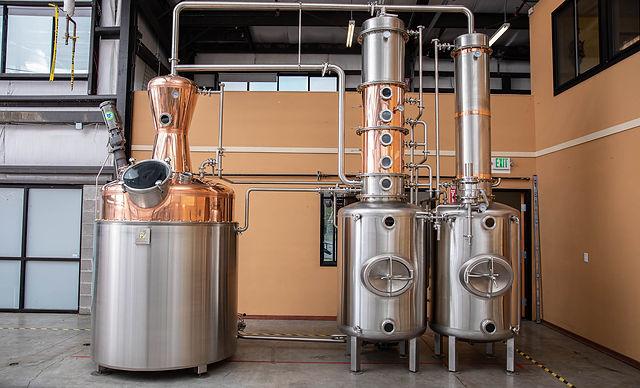Various industries widely use distillation as a fundamental separation process to purify liquids, separate components, and create valuable products. Furthermore, it is a critical process for achieving high-purity chemicals, fuels, and pharmaceuticals. Distillation equipment plays a pivotal role in this process, enabling the separation of volatile components based on their boiling points. In this article, we will explore the essential aspects of distillation equipment and processes, highlighting the significance of choosing the right distillation equipment supplier.
Distillation Equipment:
Distillation equipment is a collection of specialized devices and apparatus designed to facilitate the distillation process. Moreover, it comprises several key components that work together to separate and collect the desired components from a mixture.
The primary components of distillation equipment include:
-
1. Distillation Column:
-
The distillation column is the central component of any distillation setup. It consists of a vertical cylindrical vessel with several trays of packing materials. In fact, the column provides a means to create multiple vapor-liquid contact stages, allowing for efficient separation of components.
-
2. Reboiler:
A reboiler heats the liquid feed entering the distillation column, and this crucial heat input vaporizes the more volatile components, causing them to rise through the column.
-
3. Condenser:
-
The condenser is responsible for cooling the vaporized components back into liquid form. Furthermore, it usually comprises a heat exchanger where a cooling medium circulates to facilitate condensation.
4. Distillate Receiver:
-
This vessel collects the desired distillate, which contains the separated components of interest. Furthermore, it’s an essential part of the equipment as it stores the final product.
-
5. Reflux Drum:
-
The reflux drum is a reservoir for collecting condensed vapor from the condenser and returning it to the column. Moreover, this reflux enhances the separation efficiency by maintaining a balance between the vapor and liquid phases in the column.
Distillation Processes:
Various types categorize distillation processes, depending on their specific applications.
Some common distillation processes include:
-
1. Simple Distillation:
-
This is the most basic form of distillation, where a liquid mixture is heated in a flask, and the vapor is condensed and collected in a separate container. Next, it is suitable for separating components with significantly different boiling points.
-
2. Fractional Distillation:
-
Fractional distillation is used when the boiling points of the components to be separated are closer. The distillation column is packed with trays or packing materials, allowing for multiple vapor-liquid equilibrium stages. Furthermore, this process is highly efficient and is often used for refining crude oil into various fractions.
-
3. Vacuum Distillation:
-
In vacuum distillation, the pressure inside the distillation column is reduced, allowing for the separation of components at lower temperatures. Next, it is commonly employed in the petrochemical industry for separating high-boiling point compounds.
-
4. Azeotropic Distillation:
-
Azeotropic distillation is used when azeotropes, which are mixtures with constant boiling points, are formed. Moreover, this process involves the addition of an entrainer to break the azeotrope and separate the components effectively.
Choosing the Right Distillation Equipment Supplier:
Selecting the right distillation equipment supplier is a crucial decision, as the quality of the equipment directly impacts the efficiency and reliability of the distillation process.
When searching for a distillation equipment supplier, consider the following key factors:
-
1. Experience and Reputation:
-
Look for suppliers with a proven track record and a positive reputation in the industry. Next, experienced suppliers are more likely to provide high-quality equipment and reliable customer support.
-
2. Customization:
-
Different applications may require specific distillation equipment configurations. Also, a reputable supplier should offer customization options to tailor the equipment to your unique needs.
-
3. Compliance and Certification:
-
Ensure that the equipment supplier adheres to industry standards and regulations. Next, look for certifications and quality control measures to guarantee the equipment’s safety and performance.
-
4. Technical Support:
-
Distillation equipment can be complex, and technical assistance may be required during installation and operation. Therefore, choose a supplier that offers comprehensive technical support to address any issues that may arise.
-
5. Cost and Value:
-
While cost is a factor, it should not be the sole determining factor. Consider the overall value offered by the supplier, taking into account equipment quality, customization, and after-sales support.
The Wayforward:
In a nutshell, distillation equipment and processes are essential in various industries, contributing to the purification and separation of components in different mixtures. Selecting the right distillation equipment supplier is a critical decision, as it directly influences the success of your distillation operations. By considering factors such as experience, customization, compliance, technical support, and overall value, you can ensure that you choose a reputable supplier capable of providing high-quality equipment to meet your specific needs. Distillation remains a cornerstone of modern chemical and industrial processes, and it continues to evolve with advancements in technology and engineering.
Related Blogs Links: https://www.alaquainc.com/distillation-equipment/




